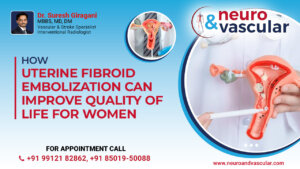
How Uterine Fibroid Embolization Can Improve Quality of Life for Women

Uterine fibroids, noncancerous growths in the uterus, can significantly impact a woman’s quality of life. While these growths are generally benign, they can cause various symptoms, including heavy menstrual bleeding, pelvic pain, and reproductive issues. In recent years, Uterine Fibroid Embolization (UFE) has emerged as a groundbreaking and minimally invasive alternative to traditional surgical treatments. In this blog, we’ll explore how UFE can improve the quality of life for women facing the challenges of uterine fibroids.
Uterine Fibroids and their Impact:
Uterine fibroids, also known as leiomyomas or myomas, are growths that develop within the uterine wall. These noncancerous tumors vary in size and can cause a range of symptoms, affecting women in their reproductive years. Common symptoms include:
- Heavy Menstrual Bleeding:
- Prolonged and heavy menstrual periods can lead to fatigue and anemia.
- Pelvic Pain and Pressure:
- Fibroids can cause discomfort or pain in the pelvic region, often accompanied by a feeling of fullness or pressure.
- Frequent Urination:
- Fibroids can press against the bladder, causing a frequent urge to urinate.
- Painful Intercourse:
- Fibroids can interfere with sexual activity, causing pain or discomfort.
- Reproductive Issues:
- Fibroids can impact fertility and increase the risk of complications during pregnancy.
Traditional Treatment Approaches:
Historically, the management of uterine fibroids often involved surgical interventions, such as hysterectomy (removal of the uterus) or myomectomy (removal of individual fibroids). While these procedures can be effective, they come with significant drawbacks, including longer recovery times, potential impact on fertility, and the risk of complications associated with surgery.
Uterine Fibroid Embolization: A Minimally Invasive Alternative
Uterine Fibroid Embolization (UFE), also known as uterine artery embolization, has emerged as a less invasive and highly effective alternative to traditional surgical treatments for uterine fibroids. This outpatient procedure is performed by interventional radiologists and involves the following key steps:
- Identification of Blood Vessels Supplying Fibroids:
- Using imaging techniques such as angiography, the interventional radiologist identifies the blood vessels that supply the fibroids.
- Embolization of Blood Vessels:
- Tiny particles, usually made of polyvinyl alcohol or tris-acryl gelatin microspheres, are injected into the blood vessels supplying the fibroids. These particles block the blood flow to the fibroids, leading to their shrinkage.
- Reduction in Fibroid Size and Symptoms:
- With the blood supply cut off, the fibroids begin to shrink. As they decrease in size, symptoms such as heavy bleeding, pelvic pain, and pressure are alleviated.
How UFE Improves Quality of Life:
Minimally Invasive Nature:
One of the key advantages of Uterine Fibroid Embolization is its minimally invasive nature. Unlike traditional surgeries, UFE is performed through a small incision, typically in the groin area. This results in reduced scarring, less postoperative pain, and a quicker recovery.
Preservation of the Uterus:
Unlike hysterectomy, which involves the removal of the uterus, UFE allows for the preservation of the uterus. This is particularly crucial for women who wish to maintain their reproductive potential and have the option of bearing children in the future.
Quick Recovery:
UFE is an outpatient procedure, meaning that women can typically return home on the same day. The recovery time is generally shorter compared to traditional surgical options, allowing for a quicker return to daily activities.
Alleviation of Symptoms:
Uterine Fibroid Embolization directly targets the root cause of uterine fibroids – the blood supply. By reducing the blood flow to the fibroids, UFE effectively shrinks the tumors, leading to a significant reduction in symptoms such as heavy menstrual bleeding, pelvic pain, and pressure.
Fertility Preservation:
For women who desire to preserve their fertility, UFE offers a non-surgical alternative. By targeting only the blood vessels supplying the fibroids, UFE allows for the potential preservation of fertility without the need for invasive surgery.
Improved Quality of Life:
Perhaps the most profound impact of Uterine Fibroid Embolization is the improvement in the overall quality of life for women. The relief from the debilitating symptoms of uterine fibroids allows women to regain control over their bodies and daily activities. The emotional burden associated with heavy bleeding, pain, and reproductive concerns is lifted, contributing to a positive and empowered outlook on life.
Conclusion:
Uterine Fibroid Embolization stands at the forefront of transformative advancements in women’s healthcare. This innovative, minimally invasive procedure offers a beacon of hope for those grappling with the challenges posed by uterine fibroids. Through its ability to preserve fertility, alleviate symptoms, and significantly improve the quality of life, UFE empowers women to embrace a future free from the constraints of fibroids. As medical science continues to evolve, Uterine Fibroid Embolization remains a testament to the personalized and empowering approach to women’s health, ensuring that every woman has the opportunity to lead a life unrestrained by the burdens of uterine fibroids.
About the Author:

Name: DR . SURESH GIRAGANI
INTERVENTIONAL RADIOLOGIST
DR. SURESH GIRAGANI CONSULTANT INTERVENTIONAL RADIOLOGIST at Apollo hospitals Jubilee Hills has more than sixteen years of clinical experience in vascular interventions with a special interest in neurovascular and peripheral vascular disease interventional procedures.